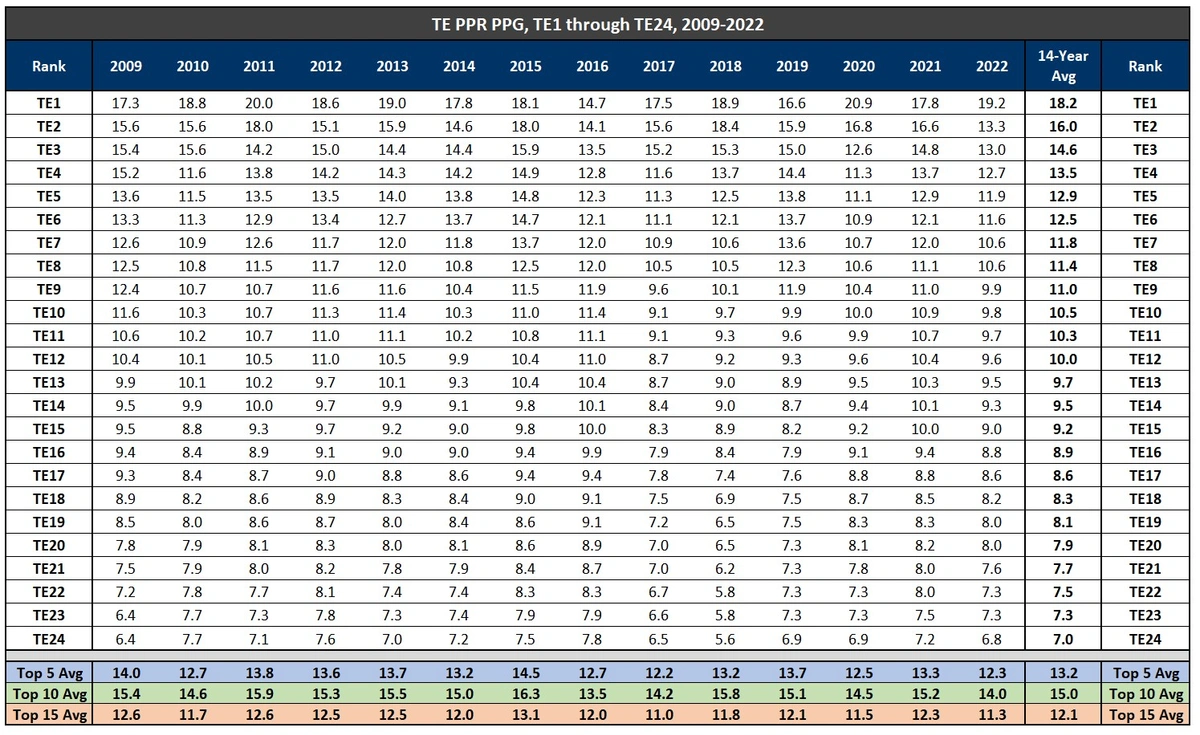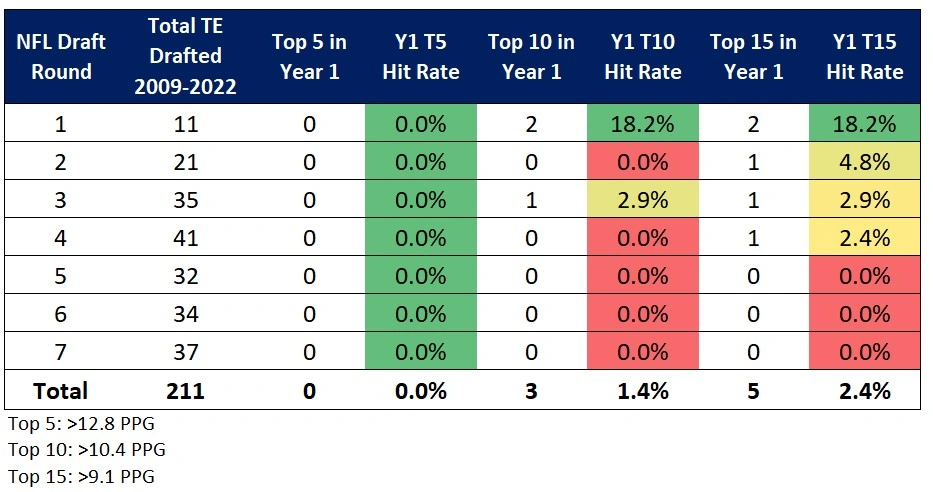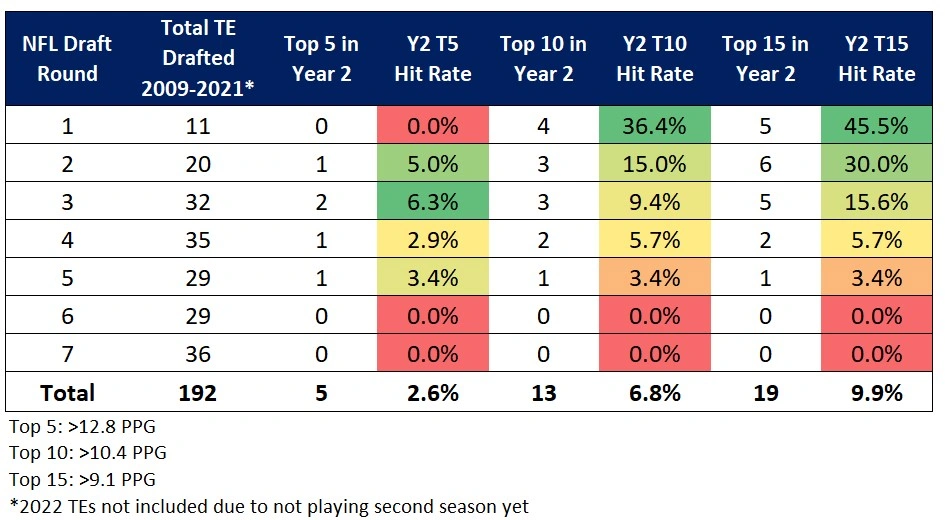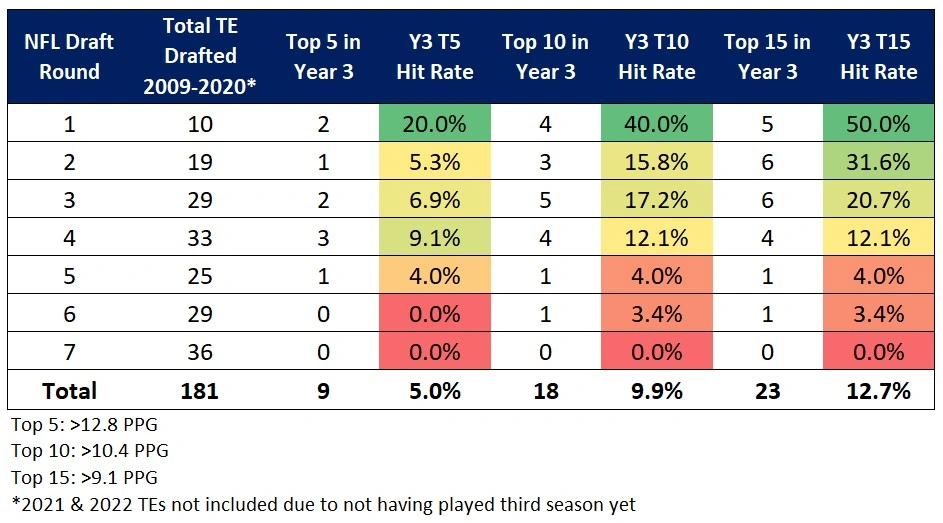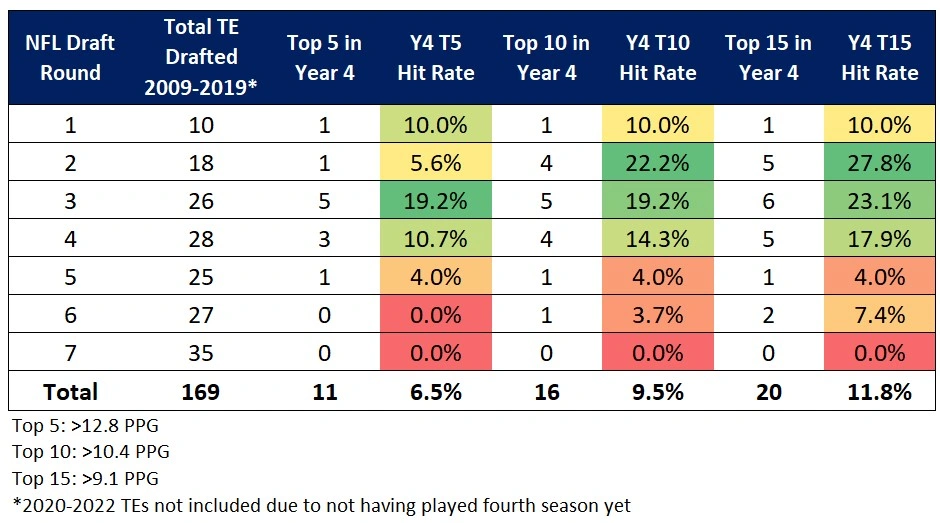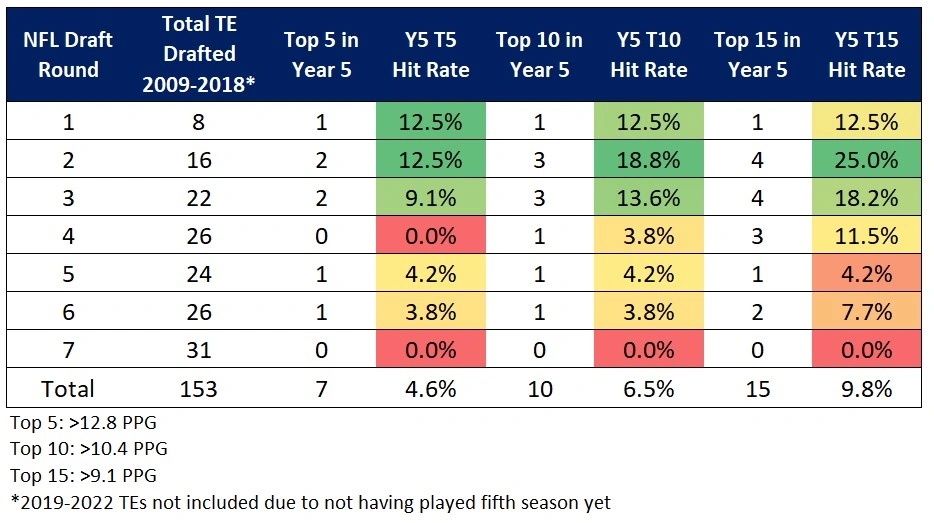Beware of Rookie Tight Ends?
It is said that “looks can be deceiving.” The same can be said for surface-level statistics in fantasy football. During the 2022 NFL season, this weekly article series looked beneath the statistical surface, beyond the standard box score, using the premium statistics provided by FantasyData, including advanced and efficiency metrics across the fantasy skill positions, to search for puzzle pieces that fit together. I will be continuing the “Beneath the Surface” series with multiple articles during the 2023 offseason both looking at some historical statistical trends and recapping the 2023 season from an advanced stats angle.
In my last article, I dove deep into the potential fantasy impacts rookie QBs have had on TEs. Is there a small spike in TE volume due to acting as a “safety valve” for a young signal-caller? Or does that lack of NFL experience have a negative fantasy impact on TEs, as it typically does for WRs? Here is a link to that article.
For this article, I will be moving the word “rookie” in front of the TE instead of QB. A brand new group of rookie TEs have entered the NFL as part of what we many have described as one of the best TE classes in years. Dalton Kincaid, Michael Mayer, Sam LaPorta, and Luke Musgrave seem to be the top four and relatively hot commodities in dynasty formats, especially with a premium for TE receptions. I drafted Kincaid as my TE1 in a recent dynasty startup draft. In today’s fantasy football, whether dynasty or redraft, having one of the top-tier TEs is a distinct advantage at the position. Selecting Travis Kelce in the first round of a redraft league is very common and highly recommended (by me as well). So, it is understandable that we all spend time and draft capital searching for that next big TE advantage.
But what does it look like historically?
Does a high cost of acquisition make sense based on what we have seen from TEs, even the best of the best, in their rookie year or their first few years in the NFL?
There is a distinct difference here depending on the format. With rookie TEs, only that first-year matters for redraft formats. Yes, gaining knowledge about historical TE trajectories beyond their rookie season is useful in redraft. We want to put our best effort forth in projecting when a TE might break out beyond their rookie season. We always strive to be ahead of the curve (and our league mates) in predicting a TE breakout (or any position) before it happens. Fantasy football has evolved to a point where gaining edges on your competition has gotten more and more difficult. This is why so many people (myself included) spend so much time not only looking for diamonds in the rough but also projecting when players we know are capable will hit. Getting good value on a player, especially one that ascends into the upper echelons of fantasy scoring, remains one of those edges and always will be.
And this isn’t about the Saquon Barkley’s and Ja’Marr Chase’s of the world, players for whom it would have made much less sense for them to not break out right away. This is about players like Mark Andrews leading up to the 2021 season. Based on where he was being drafted, he transformed into one of those positional edges in 2021. The same can be said for Stefon Diggs in 2020 and Cooper Kupp in 2021. Prior to those seasons, most of us viewed both of these WRs far differently.
In dynasty formats, you don’t always have the luxury of waiting until just before the breakout to pounce, as players capable of this type of ascension are typically rostered. But in redraft, while it is beneficial to try and increase your odds of predicting which upcoming season might be the one to take an Andrews of the curve, it is important to determine the likelihood of that happening during that first rookie season.
When we transition into redraft season there will be a pool of TEs for whom we try and figure out “Could this be their breakout year? Should I target one of these TEs later in my drafts in hopes of being ahead of the hit? Who is this year’s 2021 Mark Andrews?” One of the primary purposes of this article asks the question: Should that pool include rookie TEs?
In dynasty formats, it’s not quite as simple. Only looking at rookie seasons does not tell much of the story because our expectations and intentions are different (or at least they should be) when drafting rookie TEs (or a rookie at any position). As stated, I drafted Kincaid as my first TE in a recent startup. I did not do this expecting him to be Travis Kelce in year one. I paid a premium based on my long-term outlook for him in Buffalo, knowing I will likely have to rely on a veteran I selected later in 2023. Plenty of rookies are drafted in dynasty with little expectation of significant fantasy relevance during that first NFL season. The long-term approach of dynasty makes this a necessity. And obviously, it makes no sense in redraft. So, I will follow the rookie season data geared toward redraft leagues with historical data looking at TE hit rates over the first three to five seasons which is more useful for dynasty leagues.
Establishing the TE “Hit Rate”
There were two prerequisites I needed to establish before digging into the TE fantasy seasons:
- Determine which range of seasons to include in the data set. I wanted to go back far enough to generate a decent sample size of TEs, but not too far back, to a point in the NFL that is no longer representative of current conditions.
- Determine what type of threshold to measure against. In order to call something a “hit” or a “success,” there needs to be a minimum threshold.
Historic Range
Starting with the historic range, I chose to go back to 2009. I arrived at that by charting the TE PPG at each TE finishing spot (TE1-TE24) going back to 2002. I then looked at a couple of different trends. I looked at the average PPG for the Top 5, Top 10, and Top 15 TEs for each season and observed the fluctuations. Between 2008 and 2009, the Top 5 average increased by, the Top 10 by, and the Top 15 by. This represented the largest year-over-year increase and the averages have remained around that 2009 level since (with a downtick from 2017-2019). I also counted how many TEs finished with double-digit PPG in each season. Again, there was a jump between 2008 (6) and 2009 (12) and it had been above 10 the majority of seasons since.
There will always be a level of arbitrary subjectivity when choosing starting points like this. But I think 2009 best represents when the current version of TE fantasy scoring began. Even though it would create a larger sample size, we wouldn’t want to go back to 2002, when only one TE scored more than 10.0 PPG.
Establishing the Threshold
The second requirement of this research was establishing a threshold to measure against. I use the term “hit rate” because it is common vernacular in the fantasy football world and a recognized term. What it means is easily definable. In this case, I used Point Per Reception (PPR) fantasy points per game (PPG) as the unit of measurement and established a few different minimum PPG thresholds. If a TE’s PPG was above the threshold, it is considered a “hit.” For any position, you will commonly see season-long PPG ranks used as thresholds. Such as whether a player finished in the Top 24 or Top 12.
In general, use this as well, but slightly different. I think the data is stronger when this is tied to actual PPG numbers rather than simply the rankings for an individual season. What I mean by this is I don’t just look at each of the TEs and count how many times they made the Top 12 or 24 in each of the individual seasons. There are too many qualitative variables that can be in play. A few injuries can decrease the pool any given year and a TE can pass the rank-only threshold aided by that. Scoring fluctuates, where a Top 12 finish one year would be outside the Top 12 in another.
Instead, to sift through some of that noise, I used the average PPG of the TE1, TE2, TE3, and so on through the TE24 from 2009 through 2022 I had already generated to determine my historic range. This provides a PPG threshold based on a 14-year average to where we are only looking at TE PPG, not where they finished that particular season. I just think it’s better data when saying “This TE finished above the historical TE12 PPG threshold five times” rather than “This TE finished in the Top 12 five times.”
Here is the average TE PPG data from 2009-2022:
I have done this same study for RBs and WRs and used the typical Top 12 and Top 24 PPG thresholds. But fantasy relevance is different for TEs. Outside of leagues where you are required to start two TEs, using Top 24 PPG as a threshold sets the bar too low. Instead, I used thresholds I feel are more relevant for the TE position: Top 5, Top 10, and Top 15. My thinking is there are approximately 15 TEs who can be fantasy relevant in redraft leagues in a given year. Beyond that is a group of TEs that aren’t likely being rostered, let alone started, so measuring against the Top 24 threshold wouldn’t be useful.
Rookie TE Hit Rates
Now we have the three PPG thresholds used for this research. Top 15 (greater than or equal to 9.2 PPG) Top 10 (greater than or equal to 10.5 PPG), and Top 5 (greater than or equal to 12.9 PPG). I charted every TE who was drafted between 2009 and 2022, and their rookie season PPG. Here are the results, broken down by the round each TE was drafted in.
If I were lazier, I would just say “The End” right here. There have been so few rookie-season hits that including the NFL Draft isn’t necessary. Draft capital is such a significant piece when looking at historical hit rates for rookie RBs, WRs, and QBs. But it has meant very little with TEs.
There has not been one TE in the 211 drafted since 2009 who has finished above the Top 5 PPG average during their rookie season. Gaining that value-based edge at the TE position is just not going to happen with a rookie TE. Only three TEs (1.4%) have finished Top 10. Those TEs were Kyle Pitts (12.7 PPG in 2021), Evan Engram (11.6 PPG in 2017), and Jordan Reed (12.7 PPG in 2013. And two of the three (Pitts and Engram) were first-round draft picks. Five TEs (2.4%) have finished Top 15. The TEs mentioned above along with Pat Freiermuth (9.4 PPG in 2021) and Aaron Hernandez (10.1 PPG in 2010). Rob Gronkowski, George Kittle, Mark Andrews, and Travis Kelce. None of them finished above the Top 15 PPG threshold in their rookie year.
It is not a revelation that the hit rates for rookie TEs are this low. It is no secret TEs take longer to develop (fantasy-wise) than RBs, WRs, and WBs. But for me, it is important to view and confirm that notion through this historical lens. But the data is clear. The odds of a rookie TE hitting in their rookie year are extremely low. If you are drafting the newest shiny rookie TE to be your starter in a redraft league, you are playing a numbers game you are not likely to win. TEs have been getting more athletic, and it’s easy to fall in love with a TE when they have a great combine, are drafted early, and/or are drafted to a good landing spot. But that happens every year. And this is still the historical data. And while I do not advocate for rostering two TEs in redraft leagues, if you want to take a swing with one of the rookie TEs, like Kincaid or LaPorta, make sure it’s as a stash with a non-rookie TE as your starter.
The Dynasty Lens
As discussed, it’s a completely different ballgame in dynasty formats. You should still avoid drafting a rookie TE to be your starter in 2023. But it’s dynasty, and the startup and rookie drafts are all about value. You are not drafting to fill a starting lineup like you are in redraft. This is why I chose Kincaid as my first TE drafted. In my view, the spot where I selected him was a great value, even though I know it will likely not be wise to start him much during the season. But the season is months away. A common saying in dynasty formats is “You draft for value and trade for need.” You try to fill your roster with value regardless of position during the draft, then you have multiple months to try and work out deals (using that value) to fill needs. It’s entirely possible that if Kincaid, who already has a lot of hype, gets hyped up anymore, whether it’s an overreaction to a practice video or he balls out in a pre-season game, I will try to move him before the season starts. Those are the options available to you in dynasty.
What is more important and useful for the multi-year environment of dynasty leagues is to look at TE hit rates over the course of multiple seasons. What has that looked like? We know the hit rates in year one are low, but knowing how often a TE hits by year three, or year five, is extremely useful data when making decisions in dynasty. Maybe avoiding rookie TEs altogether is something to consider in dynasty as well. If the odds of a TE hitting don’t become favorable until farther into their career than RBs and WRs, then maybe the best method is to let someone else draft them as rookies, then play the waiting game. Let the TE inevitably lose value and pounce at a later time. Because even though the reasonable expectation should be that TEs take time, a player’s market value is based on humans, not objective historical data. When a TE like Trey McBride, who was the first TE selected in the 2022 NFL Draft, caches only 29 passes for 265 yards and one TD his rookie year, his value will be lower than it was during 2022 rookie drafts. I am not necessarily recommending pursuing this strategy with McBride. He might just be bad. But in general, it is something to add to your bag of options. Don’t be the one who overreacts when the thing that was very likely to happen does in fact happen.
So, what does the data say? The following is the summary of hit rates over the first two to five seasons. This TE pool is smaller than that for the rookie season-only data. The reason is straightforward. Players drafted after 2019 have not played four seasons yet, after 2020 have not played three, and so on. So, the TE pool was set up as follows:
- Hit rates in second season: TEs drafted from 2011-2021
- Hit rates in third season: TEs drafted from 2011-2020
- Hit rates in fourth season: TEs drafted from 2011-2019
- Hit rates in fifth season: TEs drafted from 2011-2018
Here are the TE second season results:
This is where you do need to pay attention to draft capital. In year two the hit rates are still low, especially for Top 5 PPG, but you start to see the increase in Top 10 and 15 TEs, including the same Day 2 cliff for TEs drafted after the third round. For second-year TEs, 15.9% of Round 1-3 TEs put up a Top 10 PPG. The rate for Round 4-7 TEs, 2.3%.
Here are the third-year TEs:
In year three, the Top 10 cliff shifts somewhat to after Round 4 instead of Round 3. This is also where first-round TEs begin to show up, not as much in the number of TEs hitting, but rather, in increased hit rates relative to the previous data.
Here are both fourth and fifth-year TEs.
Interestingly, Round 3 TEs have the highest Top 5 hit rate among fourth-year TEs, while Round 2 TEs dominate the Top 10 hit rate. The draft capital cliff also stands firm after Round 4. By year five we see the overall hit rates starting to creep back down. And in case you hadn’t guessed, that lone player keeping the Round 5 above 0.0% year after year is George Kittle, the biggest TE outlier, followed by sixth-rounder Darren Waller.
I’ll conclude with one last piece of data I find helpful. Looking at the drafted TEs between 2009 and 2018, the following shows the hit rates in years four and five if there are no hits in years one through three. For this, I am not including the Top 15 threshold. If a TE has not hit a Top 5 or Top 10 PPG in their first three years, what are the chances he will in year four or five? This is why I’m stopping at 2018 because anyone drafted after that cannot have played five seasons yet. This same data set paints a pretty grim picture for WRs after year three. I wanted to see what it has looked like for TEs.
Of the 153 TEs drafted between 2009 and 2018, 125 did not put up a Top 5 or Top 10 PPG during their first three seasons. Of those 125 TEs, only six went on to finish with a Top 5 or Top 10 PPG in year four or five. That is a hit rate of 4.8%. Those lone few TEs were:
- Brandon Myers
- Zach Ertz
- Darren Waller
- Austin Hooper
- Hunter Henry
- Dalton Schultz
And that’s it.
Thanks for reading! If you have any questions about the data presented in this article or about fantasy football in general, feel free to hit me up on Twitter @MunderDifflinFF.


